#but that is an inherently open to interpretation concept
Text
Ena the Order is the concept of conforming to Fate, and Elio is an Emanator of Order
welcome to my pre-2,2 theory, i got carried away.
for those yet unaware, theres been a theory flying around that the Goddess of Sigonia, Gaiathra Triclops, is a folkloric interpretation of Ena the Order, on account of the iris of Ena's eye having the same colors as Aventurine's. we can go much further with this though.

(Aventurine's pupils are diamond-shaped, but little Kakavasha has round pupils. its likely that diamond-shaped pupils are a result of becoming a Stoneheart, because Topaz also has diamond-shaped pupils, and Aventurine used to not have them. but i digress)
Anyway, Gaiathra=Ena. Gaiathra is described as a left palm with 3 eyes, arguably Ena also has 3 eyes- two closed ones on their face, and one massive, open eye floating around them.
Gaiathra "reigns over all matters related to fertility, travels, and trickery." (Sigonia, Planar Ornament Relic Set) and is said to have been the one to bestow Aventurine with his luck.
but first: What is Order? Based on the words alone, youd think Order would have more in common with Equilibrium, but evidently that wasnt the case. Considering it was assimilated into the Harmony, it must have overlaps with that though, since the broader path is the one that absorbs the narrower one if their concepts are too similar. So, if Harmony is unity and peace, the idea of everyone joining a happy paradise, then how did the Harmony manage to absorb Order?
"I am filled with curiosity about how THEY swallowed up Order. The hymns of Xipe continue to spread and grow, occasionally overseen by ideology. In contrast, Ena's harmonic songs seems to align within a three-dimensional framework, akin to an emperor maintaining hierarchical order among all creatures. While there may be some overlap between THEIR Paths, the ancient Order is enormous in size, and swallowing THEM would prove far from effortless... Among the Aeons, there exist countless enigmas that surpass my own speculations." - Dev Log for Xipe in Simulated Universe, Herta's comment
Herta doesnt know either, and by all means a freshly ascended Aeon should not have an easy time absorbing someone as ancient as Ena- that is, unless Ena intended for it to happen.
This is a lot of establishing facts before i get to the meat of things. We still dont technically know what Order even is, so lets try figure it out!
"The planets governed by Ena adhere staunchly to established rules, yet I must acknowledge that the various calamities in the cosmos were all hindered by Ena's guardianship, leading to extremely efficient development of civilization among diverse planets. Interestingly, however, civilizations all eventually hit rock bottom because of Order. The ancient planets that once fervently worshiped Order would shine briefly before their total collapse... Perhaps this is the "Path" of these planets." - Dev Log for Ena in Simulated Universe, Herta's comment
So: Order is the concept of adhering to a predetermined outcome- their "path". Ena observes humanity "gazing into a crystal orb containing the cosmos" and ensures that they all follow their predetermined path of Fate. None may go astray, no outside influence may interfere, no matter what fate awaits them, they must follow their set path.
"THEIR voice is composed of syllables sequencing the rise and fall of civilizations in accordance with the Aeon's path."
Ena has the ability to foresee the future, as they dont just sequence the rise, but also the fall of civilizations. They are inherently impartial, just, things are destined to happen and so they see to it that they happen. Order is the concept of conforming to Fate, if a planet is destined to be destroyed by a calamity, then Ena guides it to that outcome.
However, Aeons, despite being concepts, arent just concepts, they have some semblance of sentience, self-awareness. they have goals, they make deals, though humans are unable to comprehend them.
So, Ena conforms to fate, but what is the purpose of doing so? Ena can see the future, but we know Kafka. there isnt just ONE future, theres a lot of futures, and endless paths. So its logical to assume that Ena, by being able to see the fates of civilizations, can actually see the endless amount of paths towards all possible fates, and personally chooses which path is specifically followed. and for the sake of the theory, lets assume Ena is benevolent and guides humanity towards the most fortunate fate (though even the most "fortunate" of fates can still end in destruction)
Before Ena was assimilated into the Harmony, they made a deal with Qlipoth the Preservation: Qlipoth will bring an end to Tayzzyronth the Propagation (as they are interfering with the predetermined Fates of planets) and in turn Ena will help Qlipoth against Oroboros the Voracity somehow (likely foreseeing its Fate and interfering with it). Qlipoth held up their end of the bargain, but Ena was assimilated before they were able uphold their part, which is interesting
We know theres something fishy about the Orders assmiliation into Harmony- it doesnt make sense, especially knowing that Ena foresees the future, and is likely aware of their own fate.
Heres where we remember that Gaiathra is also a goddess of trickery. Theres two possibilities:
Ena foresaw their own "demise" and made a deal with Qlipoth knowing they wouldnt be able to follow through on their part of the promise
Ena, able to see multiple paths for the future, foresaw that being assimilated into Xipe would lead them towards the most fortunate one, so they let themselves be absorbed on purpose, as the Harmony would not have been able to absorb the Order otherwise. The deal was just a bonus.
Either way, Ena would have known of the future, and making a deal shortly before the assimiliation of their path is clearly a scheme- they get something great out of it, and dont have to follow up on it.
Heres where we bring up Elio (and the Stellaron Hunters). We actually still dont know what path they follow, and isnt that so interesting? What path could possibly include following a "script" to ensure a certain future? hmmm
sounds like Order to me!
Elio possesses the ability to foresee future possibilities and the paths that lead towards them. Essentially, the exact ability that Ena is shown to possess. All the futures look pretty bleak though, except for one, which hes trying to achieve by making sure to follow that exact path: his "script". the very definition of Order.
Note also that despite Enas assimiliation, their faction can still exist. After all, Idrila the Beauty is also gone, but the Knights of Beauty still roam around. The path of a deceased or assimiliated Aeon can still be upheld even if the Aeon no longer exists.
Anyway, Elio is basically upholding Ena's legacy by ensuring that we adhere to fate, and guides us towards the most fortunate one. His ability is far too powerful though, so its safe to assume hes an Emanator, since theyre considered to be "as good as emissaries of the Aeons' wills"
*As a bonus, Gaiathra also reigns over "all matters related to 'travels'". if you stretch the definition a little, "travels" could refer to the idea of embarking on paths towards fate. you "travel" on a path, after all.
Theres also this interesting little tidbit here:
"THEY are always so symmetrical and so equal. If we were to rank those most sublime beings, only the Voracity and the Permanence can stand toe-to-toe with the Equilibrium's antiquity... Oh, and also the Order. After Ena disappeared, the Equilibrium's duties have only grown greater. Then, how would HooH perceive Nanook?"- Dev Log for HooH in Simulated Universe, Herta's comment
The fact that Nanook is brought up is pretty funny as theyre the youngest Aeon, and since only the most ancient ones would be able to stand "toe-to-toe" with HooH, youd think as the youngest, Nanook wouldnt stand a chance against them. but they were brought up regardless, in tandem with Ena no less
Coincidentally, Nanook is also the Aeon that Elio wants the Trailblazer to defeat too. Curious! You could say that it is the Will of the Order to see the fall of the Destruction? anyway,
HooH's duties "have grown only greater" since Ena disappeared, meaning that they must have overlapped in some way before, but coexisted. (similarly to how the Remembrance and Preservation coexist, possibly) We dont know much of anything about Equilibrium yet though, so lets put that aside.
Lets talk about luck.
Luck is just chance. The results of "chance" are left up to "fate". We know that not all choices or events matter in the grand scheme of things. Theres endless possible paths, so rolling a 1 or a 6 doesnt matter because it will still lead you onto the same destiny. Luck is irrelevant to fate, it does not influence it. Luck only influences how you arrive at it.
So how do you reconcile that with Order? if Order is staunchly adhering to fate, observing humanity to ensure they all end up on the "right" path, then how does chance, luck, happenstance, fit into all this?
Luck is the ultimate Order, because there is only ONE path that luck can take: the most fortunate one. It does not influence your fate however, luck only influences which one of the countless paths towards your fate you end up on. and always being lucky narrows your potential paths down to just one.
This is also why Nihility was the natural conclusion for Aventurine. If you realize that no matter what you do, you cannot change the outcome of your choices, then you realize its futile and decide to succumb to it. youll always win, so whats the point? Thats Nihility: succumbing to Fate, the inevitability of everything, realizing your choices dont matter. When youre lucky and everything you do leads to the same result then you start to think that maybe nothing matters.
Back on track though. Fate, despite being predetermined, is not singular. as in, theres predetermined fates (plural) waiting for you at the end of your path. theres multiple endings. Luck means you have less paths to end up on but luck does not influence the end goal.
In a way, what Elio is trying to do is very similar to what Aventurines "luck" does: he wants to end up on a very specific path that leads him to a very specific fate, and luck leads you onto one single path, theoretically making it easier to achieve certain fates. Its an interesting parallel.
"Blessing" someone with luck seems a bit too hands-on for someone like Ena, so while we might never know why Aventurine was blessed specifically, we can kind of see it as a sort of trial-run. Ena does not interfere, does not "defy" fate, but bestowing luck onto someone to narrow down their futures is a bit like interference- except its not, only on a technicality. theyre still adhering to the set paths that exist, after all, im not changing fate, what are you talking about? look, hes still on one of your predetermined paths. the fact that he cant go onto other paths is irrelevant if he still ends up at one of the predetermined endings.
As a note though, Ena is not Fate itself. Ena adheres to fate and ensures that humanity follows it. Nihility is basically succumbing to fate and thinking its inevitable and change is futile, and I guess you could see Harmony as the concept of circumventing fate- instead of arriving at one of your predetermined endings, how about you get assimilated into our harmonious hivemind and experience eternal bliss? (lets wait on that 2.2 harmony lore-drop before saying anything about that though)
got off track a little. basically, Ena's Order is the concept of conforming/adhering to Fate. potentially, in their era, Fate was a singular end, because they were the one to guide humanity onto certain paths and towards certain ends (which is why civilizations thrived but ultimately still collapsed). Enas assimiliation was on purpose, although we can only speculate on the reason. so i will. heres my speculation:
Ena is not Fate itself, but a Guide. seeing the countless possible paths and possible fates for humanity, they foresaw the same thing that Elio foresees- a terrible End at the hands of the Destruction that may affect humans and Aeons alike. potentially, Enas Will mightve been to avoid that (but remaining within the confines of fate, not defying it) so they set in motion the steps needed to embark on said path, which necessitated their assimilation into Harmony. if Enas reign caused the Fates of humans to be "set in stone", then Enas disappearance could be seen as humans regaining the ability to choose their own paths, their own fate. Essentially, Enas disappearance wouldve been necessary in order to even create the possibility of an "alternate ending" and leaving the choice up to humanity.
anyway thats the conclusion thanks for coming, godspeed if you read the whole thing. im bad at keeping things short and concise. and i started rambling near the end
as a disclaimer: these are vague thoughts and i change my view on things often. if we get new info in the future that says this was all nonsense then thats that. im not trying to convince anyone. just offering a perspective for funsies
#honkai star rail#ena the order#gaiathra triclops#when the new simverse update comes out with a new harmony path and we get lore about Ena we popping the BIGGEST bottles#cough. well anyway. Order am i right.#i didnt talk about Enas imagery but its pretty insane what with the puppet strings and and giant eye and#well. to offer another perspective: genshin is very fond of describing fate as a panopticon. 'casting an examining eye on humanity'#(especially with the new lore about the crimson moon- the eye of fate and judgement)#and literally calling Fate the strings that puppeteer humanity. haha. ha. HA.#not necessarily saying hsr and gi are connected. but rather that hoyo has a definitive view of fate and often uses the same ideas#over and over again. so. rather than saying theyre connected its more like. the imagery is so similar#that you could say the heavenly principles are how theyre representing their idea of fate in genshin. and ena is hsr's idea#i just wanted to mention that though its been driving me insane#um. ena sweep. live love laugh#vampy.txt
92 notes
·
View notes
Text
being present and living it to the fullest
as consciousness, the only existing thing is you. you are all that will ever actually exist and you are always existing right now. as you know, the concept of time like the past and future do not exist. the moment you are aware of something its yours.
so my advice to you is to be present in the real moment. stop thinking about the past that isnt actually the past. what you believe is the past is actually the present being played out again because its on your awareness right now. same goes for the future.
why waste your time with unreal forms of consciousness? why not just ground yourself and be present? “but my circumstances 😔-“ are not real and do not matter. you are interpreting them based on your own perceptions. stop giving them an unbearable context and change it.
these circumstances are inherently neutral and its up to you as the observer to decide the outcome. nothing happens until you decide. whether or not you want to consciously decide, it is still your choice. you are choosing to identify with these and repeat toxic patterns
you are choosing to fall victim to them by personifying them. these circumstances only have the hold on you you believe it has. you do not have to remain caught up in them. you don’t have to identify as them. you don’t have to deny youre aware of them (that isn’t how it works.) just change the story.
here comes terminology people in the loa community like using! the “old story” or the 3d they call it sometimes, is dead. its dead in the sense that it has no actual affect on the present moment unless you allow it. 9/10 a lot of you are allowing your old story to remain. i had been for awhile without even realizing it. living in the present but also looking forward to a future. and while manifestation was possible it was just a LOT harder. so heres what you do. anything you observe, before you react, accept it for what it is. a neutral circumstance. then write the story
that is all the human condition or “life” is. “you” reacting to your own perceptions. ill use the same example as last time: my bf left me on opened so i observed it. before i reacted (reactions arent limited to interactions with the physical world) i wrote the story hes busy and he didnt have time to respond. 5 mins later he messaged me back and responded repeating the story back to me. notice how i didnt really wait or take ages to change my self concept? i accepted my role as the observer and did just that in the present existing moment.
awareness is instantaneous. the moment youre aware of something is the moment it exist. and since the present moment is the only notch of “time” that exist, by being present and observing your surroundings are you not living the human condition without attachment?
theres no desire to manifest if youre in the moment. because its just there. the moment youre aware its there so what is there to desire? what is there to manifest? stop and be silent for a second. observe the present moment with your “new” story. take responsibility and be present
© itgomyway




224 notes
·
View notes
Note
do you mind sharing a bit more about your analysis of heart,,,
i'd love to!!
(i assume this is about the heart critique piece i did a few months ago, but please correct me if im wrong!)
in terms of the "a critique on the treatment of hearts characterization" piece, i wanted to visually explore some frustrations i have had with how the fanbase seems to fall into some unfortunate patterns when it comes to hearts character.
frequently, i see heart infantilized - this either comes across as him being a kicked dog unable to help himself because he is too weak, a baby angel who did nothing wrong, or a feral gremlin child.
i think flattening his character down to any/all of these is, for lack of a better word, a bit problematic?
; one reason being it just defeats the idea of emotions being a visceral, intense thing. heart is meant to represent emotion in its purest form; i feel woobifying him takes away from that concept because it shows having emotions as being inherently weaker or less mature.
i think a lot of people kinda forget HMS aren't just tv show characters. they represent greater concepts that near everyone feels and feels uniquely - theyre more sensitive than your typical character.
thats not saying treating them as characters is bad! everyone relates to them differently because they are so personal, they make them their own and i think thats really awesome!! ; but boiling them down to these really generic tropes and making heart a baby kinda defeats the idea that emotions are a real, visceral, multifaceted concept.
; another reason i think it can be problematic is that it sometimes unintentionally comes across really ableist?
a lot of these 'fandom-y' tropes are already rooted in ableism in some way, which is bad on its own, but theres also the important addition that heart is frequently portrayed as blind.
ive seen people time and time again fall into stereotypes with heart that his blindness makes him weak/helpless/childish. truthfully I dont think people do this intentionally, but its still internalized ableism showing up.
i recognize that a lot of the people who woobify heart tend to be on the younger side, so they dont really recognize that theyre flattening him down like that- not out of malicious ignorance, but because theyre kids who havent really had the life experience yet to grasp the full concepts of the album or realize they might be implying harmful stereotypes; that doesn't necessarily mean its okay, but i think its just them being uneducated cause theyre kids and they have yet to learn that stuff.
; all that being said, im not trying to police people on how they portray characters. im not any authority on this fandom/album by any means imaginable - im just a fan like everyone else here!
like i said before, characterizing HMS is not inherently a bad thing at all ! its fun, and its what this fanbase is built on in the first place! its so great that everyone can interpret and relate to HMS so personally, i think chonny really hit it off with the concept for the album and the execution is stellar! seeing all the fanart and different interpretations of it and the characters is such a beautiful thing, no matter if its joking, lighthearted, or deep!
; at the end of the day, theres no wrong way to interpret this album, and theres no wrong way to characterize heart. more than anything that critique piece was built up frustration turned to a call to action for people to stop and think deeply for a moment about how they portray heart - to open eyes if someone might be unknowingly flattening or adding problematic ideas to their characterizations.
and to just be mindful of that going forward! 💜
70 notes
·
View notes
Text
The nail that sticks out gets hammered down

Guns, nails, katanas: I think it's interesting to read this title not just in terms of the chapter's construction, but as three notions serving the same idea, which is what we're going to develop.

The chapter opens with the students, followers of the Church of Chainsaw Man, who don't really know what to do with their weapons. They weren't even aware that they had so many, which marks a continuity with the last chapter, when Nobana wasn't even aware that there were weapons.
Their reaction becomes the opposite when their superior gives them a reason to interpret the weapons differently - they're no longer guns in the hands of children, but a continuation of Chainsaw Man's message and power.


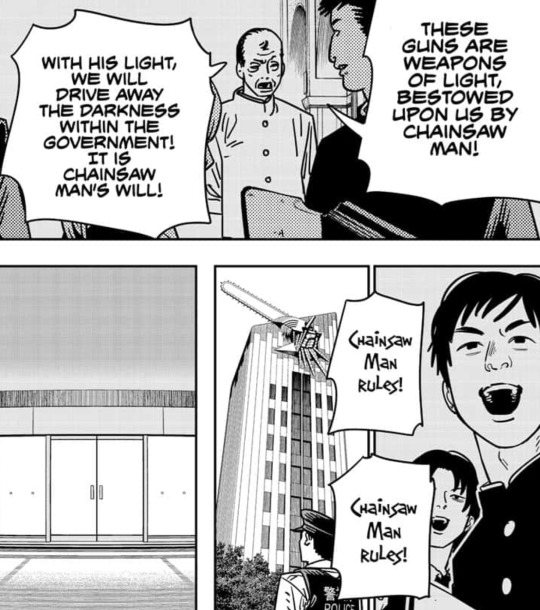
I think that's an easy interpretation to have, but it's one worth establishing for the sequel. The guns are only a third part of the reasoning, after all.
When the fiend arrives on the scene, it's also interesting the moment and the way they's cut off. Strangely enough, the fire doesn't start until they begins to suggest that children shouldn't be holding weapons, as if someone wanted to prevent them from provoking an awakening of conscience. All symbolic, of course.
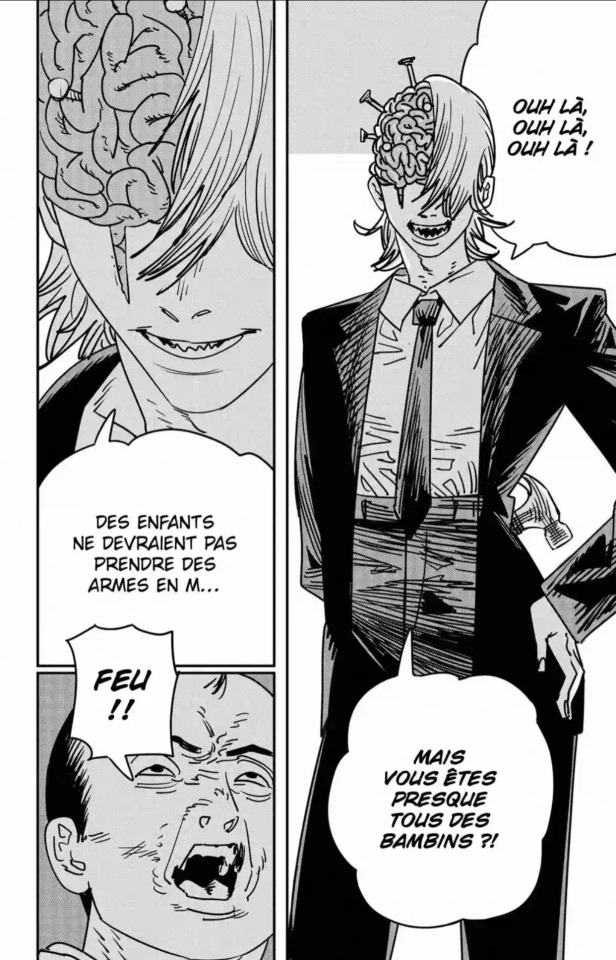
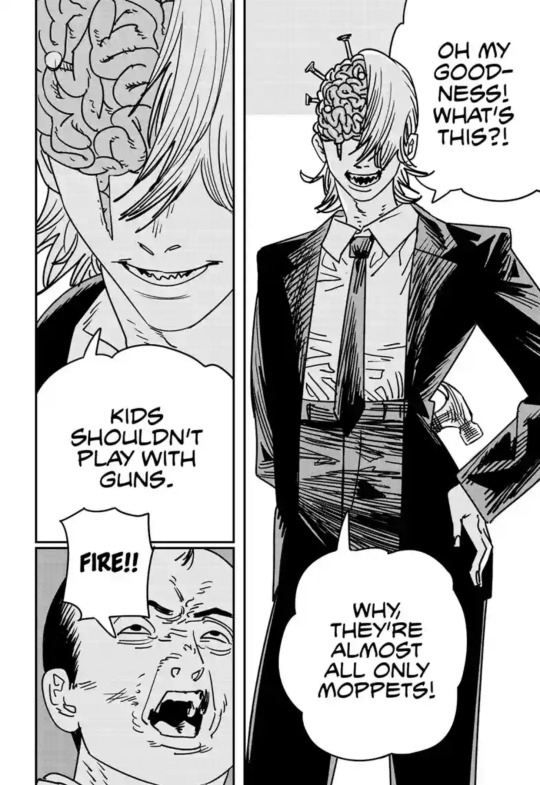
I insist on the fact that the response of the weapons is instantaneous because in French the line is well cut (I read both versions because sometimes it helps me to have a re-reading on certain lines and I perceive better the indicators notably on the tone… And yes, you missed the fiend saying Ouh Là Ouh Là Là… )
The fiend seems to have a strong desire to protect children. Which gives us an idea of the demon they might embody. A common trait that could be given to fiends is that they are beings (and I say this with all the love I bear them) intellectually limited or rather who have a way of reasoning that is more animal and demonic (logical, they are demons they embody) than human.
Whether it's Power, who only reasoned through the prism of domination, or Beam, who considered himself Chainsaw Man's pupil and follower, the possessed reason strictly through hierarchy, or rather through a kind of food chain, which is typically bestial.
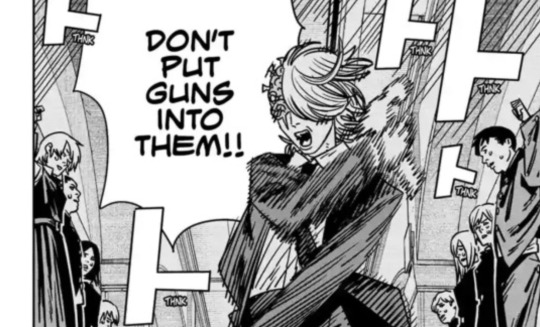

Seeing what looks like a fiend, or even a devil, reasoning in terms of child protection induces the idea that they must have something to do with these children to reason in such an abstract way as child protection.
Especially as it's something they embodies rather than understands themself, since they remains demonic, bashing in the skull of a child they themself wanted to protect, but had spoken to wrongly, as if this "lesson" were also part of his upbringing.
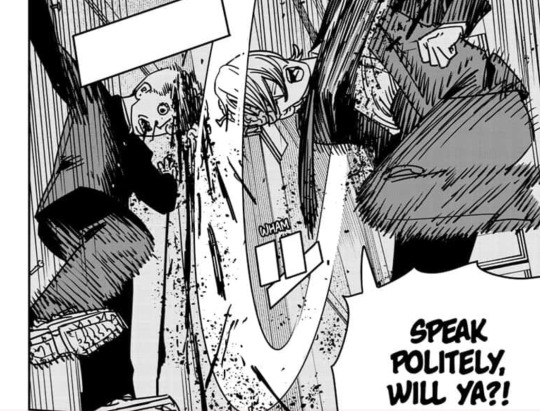
That's why I interpret this fiend as harboring the devil of studies. Which is logical? It's one of the main fears of young people in particular, whether it's the choice of direction, exams, or even because it's related to the future, studies are a subject of anxiety.
Particularly in a Japanese system in which the costs of studying are considerable, with university rankings that can be quite anxiety-provoking for high-school students.
That's why this fiend is so revolted by the sight of children with weapons, and nails them to walls rather than brutally killing them all.
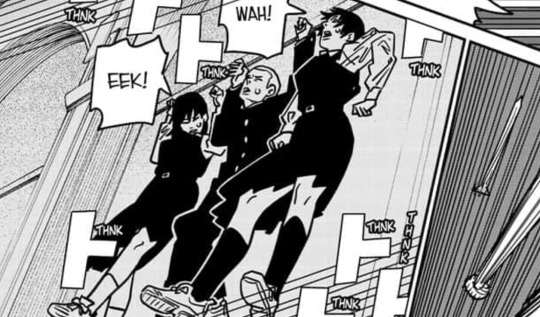
Moods and compassion are not necessarily inherent concepts in the fiends, even if they are capable of them, as we saw with Power.
But then again, if Power changed her behavior, it was only with regard to Denji and Aki, because they were part of her pack and her entourage, just like Meowy.
Sacrificing herself for Denji, even if she did in the end, was by no means obvious, hence the fact that there were several pages before her second death where she considered two options: her survival by helping Makima and her certain death to protect her brother.
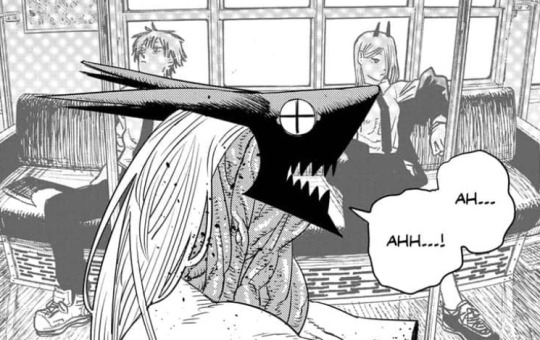
That's why the fiend's words are so strange and put me on the trail of the study demon.
Skull-hammering, or being overloaded with information and knowledge to be accumulated, is symbolized by this protruding brain.
In the same way, the fact that the demon possessed has no eyes symbolizes the school system, whose aim is to develop students without actually seeing them.
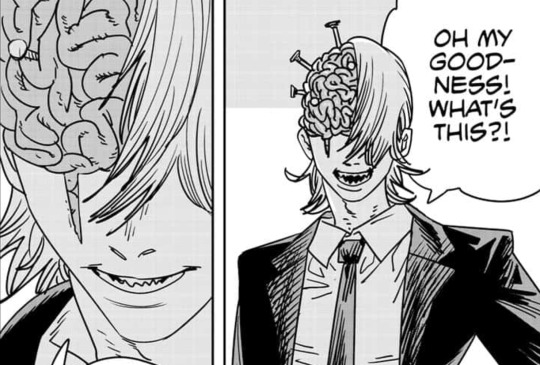
I was thinking about the hammer, but the title indicates that it's the nails we should be thinking about.
Hence the title of this analysis, which takes up a famous saying :
The nail that sticks out gets hammered down
Obviously, this saying alone cannot reflect the complexity of Japanese society, which is sometimes even used as a caricature by the Western media.
Nevertheless, without falling into caricature, it symbolizes a simple idea: Japanese society, unlike Western society, puts the collective before the individual.
This doesn't mean that the individual is completely erased, but that he is encouraged to consider his behavior from a more global angle, one that transcends himself.
It's simply a saying that can be understood as advice: if you step out of line, you can expect to encounter more difficulties.
This is as true for a Japanese society as it is for a Western one. I'm not establishing any hierarchy of values.
Hence the nails, which freeze individuals where they belong.
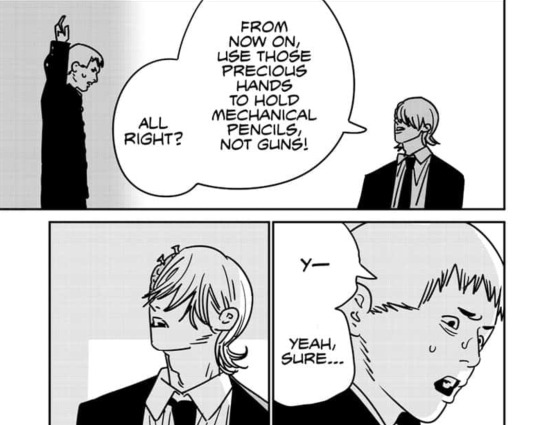
That's why this possessed person has an aversion to seeing students with guns: it's not just for protection, it's also for compartmentalization. Society doesn't give students the role of assailants; their role is to have a criterion in their hands.
We continue with this superior, who also happens to be possessed by the demon of justice. His posture is not only interesting in that it's a completely instrumentalized justice in the sense that it puts children in danger for a better purpose, but it's above all the thesis of necessary evil, i.e. fighting evil with evil.
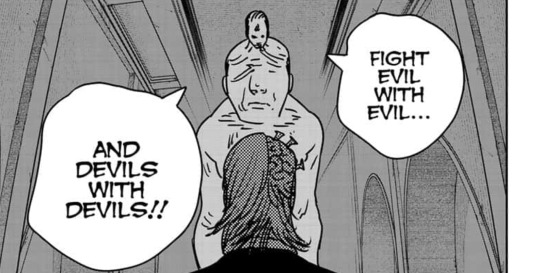

If human morality were to be summed up, it would be through this maxim: preventing wars with wars, protecting like Chainsaw Man while endangering students - that's the whole human contradiction.
So, of course, the fiend find him vain when he argues that he is the best incarnation of justice.
It's typical of man to imagine himself superior to other species.

We end on Katana, who arrives with a cutaway (which I loved) to declare that there's no justice with Chainsaw Man.
So, in one line, we put back in place all the originality of this character, and I find it incredible.

This line is both true and ironic!
True, because Chainsaw Man humiliated him by killing his grandfather, winning against him and beating his private parts with Aki to avenge Himeno.
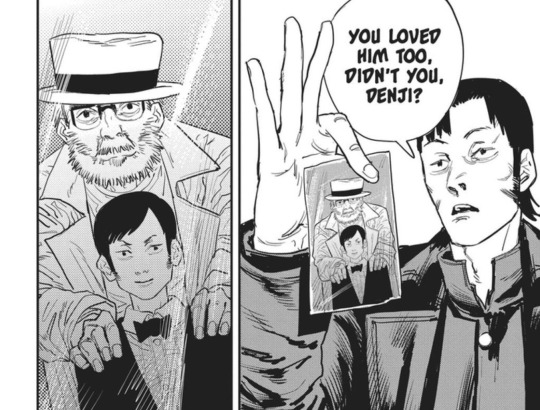

But above all, Katana Man has been brought up among the Yakuza, who he believes are governed by the same principles as his grandfather, to the point where he firmly clings to this position.
Katana Man hasn't evolved at all on this issue .
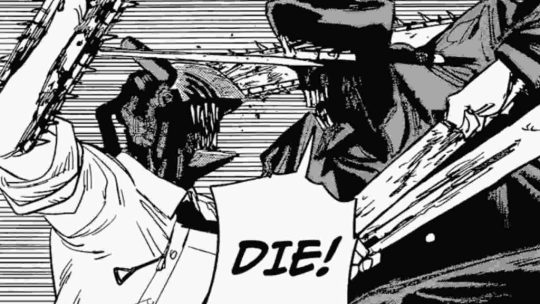
Ironic, given that Katana Man's grandfather was Denji's debt collector, the man who ended up ordering the overindebtedness and dismemberment of a child.
Indeed, Denji has no idea what justice is, for his life is profoundly unjust, whether it's being indebted for his father's misdeeds or dying prematurely.
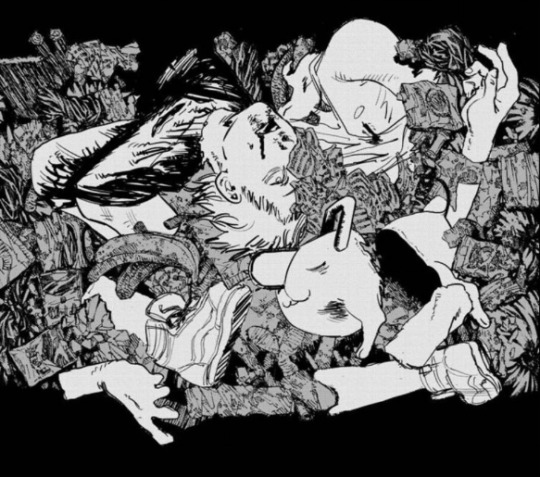
Above all, he doesn't take justice into his own hands; Denji didn't take revenge on Aki and Power with Makima, he saved her, just as he pursues his own personal goals of killing demons; they don't slaughter demons to bring justice to all those unjust deaths, he fights because they turn him on, he's an instrument, not a vigilante.
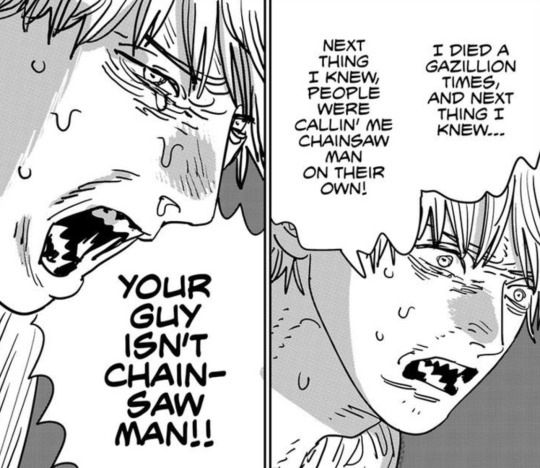
What the chapter speaks to in these three themes is the whole paradox of protection, whether it's seeking justice through the church by sending children as gunpowder.
Whether it's trying to protect these children by enclosing them in a school system.
Whether it's protecting ideals that are unfounded.
Once again we follow the analysis of the last time, public hunters choose weapons or possessions that limit the damage to the teenagers who constitute the nation's precious asset. The church uses children as a kind of barrier, not because they think they're good soldiers, but because they're moral barriers. So they send a possessed man convinced that he's protecting the children.
Or a weapon who thinks he still has a man's heart.
It's not just a clash between the two camps; it's also a battle for public approval.

Katana Man and Chainsaw Man are two sides of the same coin, the same story.
While one has known a loving grandfather whom he loves so much that he closes himself off in denial (to the point of always refuting Denji's version that he murdered his grandfather as a zombie, even though the only legacy he left him was a zombie weapon), the other has known the monster and has therefore not internalized concepts such as love, compassion or justice.
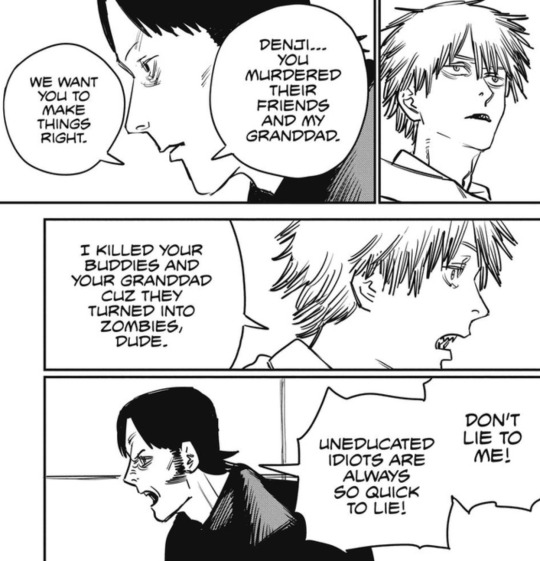
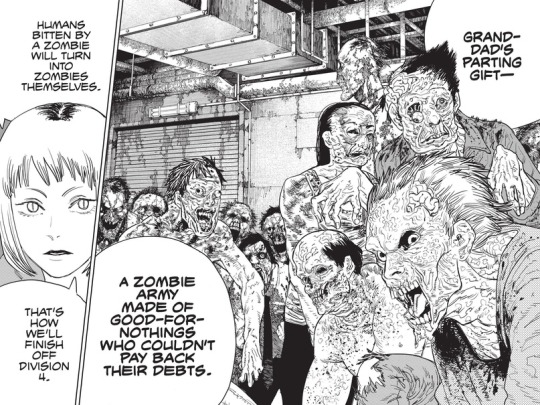
Katana Man is a weapon who has been instrumentalized by the Yakuza, and is still deluding himself to find meaning in his existence, while Denji is one of the few weapons living strictly for himself at the moment.
He's the only one who truly follows his heart !
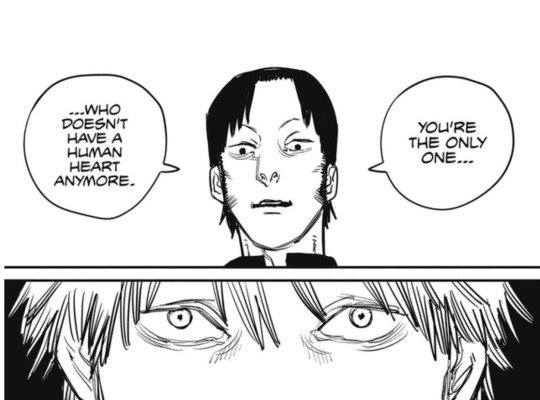
#csm spoilers#csm 144#csm 143#chainsaw man#csm part 2#csm#denji#katana man#nobana higashiyama#my thoughts
383 notes
·
View notes
Text
i remembered i can just make stuff up (stream sketches + scrapped designs)
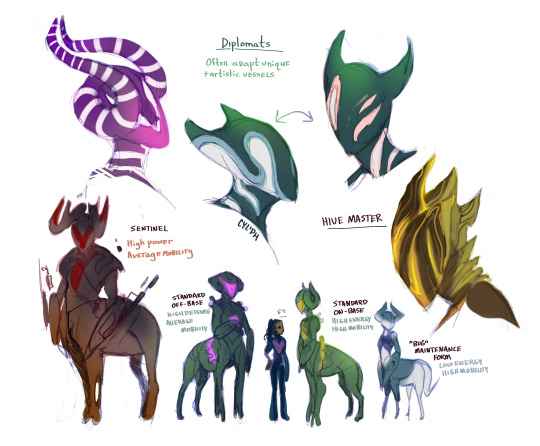
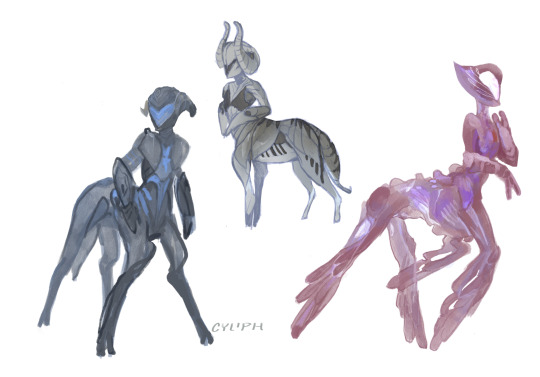
uhhhh quick fire for the second image from left to right juvenile vessel - old world cable maintenance - artistic diplomat vessel
Headcanons below the cut:
(Im not kidding word counter marked this as a 5 minute reading time open at your own risk)
While the sentiment of the architect network as "a thousand strings in a melody, not one louder than the rest" is a poetic interpretation of the network, it is not necessarily reflective of the precursors society as a whole.
At its peak, the species span billions of planets with billions on billions of individuals, all with their own degrees of autonomy and divergence. If each architect is equal in its power, than it is equal in its power to choose. Even if the soul of an architect, its very essence and its personality, is designed so perfectly that its primary desire is the perpetuation of order and advancement (two inherently divergent concepts), faults occur. Breakages occur. Pockets, cultural subsets, faded transmissions, and any other element of lost insight be it archaic or modern, lends itself to the impossibility of an entirely homogeneous society.
Whether a hive minded society reflects the only means to perfection is debatable, but its important to remember that our main portal in to the precursor world is Al-an, a known prodigy born and raised in to a society that has done nothing but benefit him. His view of his people is intrinsically skewed. He has never had a reason to see beyond the propaganda, nor question his directives. They have never once failed him.
But what of the little guys? The constructed failures so to speak. Those destined to be cast in to the bowels of poisonous cobalt mines and those who's birth purpose is to be irradiated and isolated for the greater good of the collective. Those who's genes prompted sub-standard intelligence who will never be seen as truly important. Their needs must be cast aside by design for the greater good of the collective. By design they must be ignored, their thoughts not relevant to the forwarding of progress.
Because there is true power disparity there is a true hierarchy.
Aware of this, the precursors devised a system of checks and balances to ensure that scientific progress remains at the forefront, rather than the accumulation of power by any individual.
As with all things though, power inevitably seeks to maintain and grow like a cancer.
One such exertion of power comes in the form of a "hive master". These unique individuals require precise expensive machinery in order to be produced, and as such are very rare. The vessels they require are likewise uniquely suited to only these hive masters and their unique ability to sway the voices and personality of any individual connected to the network. They themselves are invisible, completely undetectable except in physical form. Their unique telepathic abilities only work when paired with these vessels. They have no voice nor will of their own and are said to represent architect society on its most basal level.
Given their difficult to produce nature established personalities are very often used in place of new seed combinations. Personalities most suited for repurposing as a hive master include those who are most senior, intelligent, and aligned wholly with societal goals.
They are typically only found on heavily populated planets with more than a few thousand individuals. There they go undetected, like the sound of wind lost in a sea of voices, whose squall directs its very rampage. They are also enlisted for many unique duties on populous planets, such as the refactoring of corrupted individuals and silencing cultural sub-sets.
The average architect probably isn't even aware of the existence of a hive master unless their profession lies in the refactoring and diplomatic processes.
Despite the cultural drive for a monotonous and orderly society, artistic expression is common and encouraged in some sects. All architects possess the desire to express themselves, similarly to humans. Some do this simply with their inbuilt biolights that vary naturally with the individual, while others (less commonly) modify their vessel or design new and unique ones for themselves.
A vessel after all is a costly investment you cant just change like the season, its built to last you a couple thousand years. It's only natural that some seek to don something unique.
This behavior is sometimes detested by more traditional architects, but is not universally frowned upon.
Diplomats are actually encouraged to take on more artistically designed vessels. Often with their respective species' artistic values in mind. They've found greater success with alliances when they don't look like massive sticks in the mud.
Subsets of culture also at times develop unique vessels. Such as an order-over-progress movement that developed on the fringes of the network and preferred pie-bald esque vessels. Alternatively in the past as wars waged between the architects the opposing sides often don differing forms to show their allegiances. In more recent history, a wave of white-clad vigilantes advocated for a complete reset of the old-world collective.
Aside from artistic and affiliation vessels, mainstream precursor society also used a series of varying vessels to reflect personal occupation. Some of the most notable included the warrior vessel, who by design met the largest accommodations of standard architecture for the purposes of intimidation and physical altercations. Al-an's vessel likewise is very common as a heavier-built variant meant to face harsh outer worlds such as 4546B. On base, more light and energy efficient vessels make the dominant force where defense isn't a huge priority.
Microvessels such as those seen above in grey are fairly uncommon despite their energy efficiency. They are most efficient on old world planets that have been in development for hundreds of thousands of years, where the march of time means that not all builders past and present were on the same wavelength and as such small and precise forms mean that construction can be completed with minimal risk to crowded infrastructure.
Another unique and uncommon vessel is that of a juvenile grow-out vessel. These are seldom customized beyond survival needs, and are designed to acclimate a freshly generated architect to the physical world. Like a living vessel, they grow with the individual starting from broodling all the way until young adulthood. They tend to be a bit clumsy and lack the ability to interface with most technology. Always running a blue biolight, these vessels to not require a lot of energy to function physically. A juvenile architect must prove its maturity before it is allowed to graduate in to an adult vessel. This change-out phase is a diplomatic process and one can sometimes wait many years before being approved in to maturity.
The treatment of a new architect varies quite significantly depending on their birthplace and genotype. High performing juveniles are singled out very quickly for better education. Despite the rarity of children in architect society they are not given much importance. A single broodmother may be the ward of up to fifty broodlings, each of which given little attention in favor of allowing them to develop social skills among themselves. Despite architect's seeming infinite power to control resources, broodling mortality is surprisingly high.
#subnautica#sbz#subnautica below zero#architect#headcanon#hc#architect oc#precursor#fan design#fan speculation
102 notes
·
View notes
Text
so, i know this is a Take and i'm sure it may not make sense or be favorable to everyone but like, i genuinely feel that the beauty of crowley & aziraphale's relationship (including as it's depicted on screen) is in the diversity of interpretation that it is still open to even after season 2. i think (and this is my personal feeling, with which i'm sure all will not agree) there's so much nuance to What Is Romantic* that their having had an onscreen kiss can and could and should be interpreted in more than one way (which neil’s also confirmed, for what it’s worth, which with death of the author is up to each person anyway).
queerplatonic relationships can include kissing. so can explicitly romantic relationships. kisses can be sexual or nonsexual. and dedication, passion, commitment, loyalty, are not and should not belong only to romance but can and should also be found in friendship and other types of committed relationships.
and i do understand that society places a very specific definition and value on physical exchanges of affection that codes them as specifically romantic in nature, coming along with certain expectations, and it's hard to remove an onscreen kiss from that interpretation. but even so, i think the purpose and the entire point of crowley and aziraphale's entire relationship is their defying of norms, and the picking & choosing of which human social conventions they wish to act on as well as how to interpret them.
(as just some examples: crowley wears a lot of clothes from the women's section, while openly stating he isn't a "lad" and would presumably openly deny being a woman as well because he doesn't actually fit into any human conception of gender but chooses to present in very specific ways as suits him. same for aziraphale's performance of his gender. other conventions they pick and choose from as suits them: crowley introducing aziraphale to and aziraphale making an art out of enjoying food, them both enjoying different forms of human art and culture, aziraphale choosing not to use technology while crowley does use it, crowley changing his appearance tons of times while aziraphale wears the same clothes for generations and deeply values their preservation, aziraphale not actually engaging in the proper duties of a landlord while technically having maggie "rent" her shop space from him, speed limits and traffic laws are for everyone else as far as crowley is concerned, etc.)
so, like... i would hardly say that anything about their relationship and how they express their care for each other is entirely conventional, and even if it is perceived in certain ways by the humans around them, that never necessarily means that the humans have the full grasp of it or get it exactly right. crowley and aziraphale can kiss and have sex, or they can kiss and not have sex, or they can not kiss or have sex at all. crowley's kiss can mean a multitude of things. the depth and uniqueness of their relationship and their connection to each other (regardless of how that connection is interpreted) is the point. [one could argue gabe and beelzebub's relationship makes crowley and aziraphale's not unique in its angel/demon nature, but gabe and beelzebub aren't bound by the same degree of duty/responsibility/conscience/trauma/etc. which allows them to go off together while crowley and aziraphale are uniquely bound up in those things. but anyway.]
they do and have done a gazillion things for each other that could already be interpreted in multitudes of ways even before season 2, but the nonnegotiable interpretation of all of these acts is that through them, they show their undeniable importance to each other. in my opinion, their relationship IS ineffable in that it is characterized by a bond that transcends (and somehow also encompasses) all definition and classification and that is (to me! ymmv) so inherently liberating. it allows us the audience to identify with it in various ways and take whichever readings we like from it that feel most authentic to us. and it also means that even if there is a "conventional" reading to their actions it doesn't/shouldn't negate other meanings/readings/interpretations/etc.
(*what is Romance is so complicated to me and there is a lot to unpack there... may or may not try to do this in a separate post if i have the spoons at some point)
thanks for coming to my TED talk haha
#while i personally read them as romantic all i'm trying to say is that i don't think the kiss closed the door on aroace readings#good omens#good omens 2#ineffable husbands
145 notes
·
View notes
Note
I think people forget that atheism ≠ anti-theism. Like in the same way, say, asexuality ≠ anti-sex/sexuality. Somebody talking about how antisemitism is bad is not saying people who don't believe in god are Bad, they're saying being against religious people is bad. And for asexuality, not being sexual yourself does not automatically mean you are against people who are
From what I've seen the basis for antitheism is "religion is inherently harmful and getting rid of religion will improve the world." but the problems with that imo are:
religion is a made up concept that's almost meaningless. like its a well known issue that "religion" is such a vague concept that is deeply western which is why its often really really hard to apply it to the vast majority of human spiritual traditions. hell even "religio" in the context of roman polytheism doesn't map exactly onto the concept of "religion"! like in a lot of cases the line between "religion" and "philosophy" is blurred or nonexistent. not to mention that there are religious atheists. jewish atheists are probably the best example since judaism tends to be far more open to that kind of complexity & fosters a culture which allows people to engage with judaism in a variety of ways. but there are people who don't believe in god or jesus-as-savior but are christians for cultural or philosophical reasons. there are tons and tons of atheists buddhists because its a helpful way of engaging with life regardless of whether or not you believe in samsara literally. the idea that there is this strict binary between Religion and Atheism is, like all binaries, made up.
scapegoating religion for all of humanity's problems is just unhelpful. the idea that religion is this force will propels people to do bad things, and that without religion we wouldn't do them, ignores how humans shape religion to our benefit. there's a reason that wealthy kings who want to maintain power emphasize interpretations of the bible or quran that endorse war while downplaying the ones that endorse peace and compassion. for the same reason that people will support philosophies that view humans as inherently mean and violent and in need of control instead of ones that view us as capable of communal care and cooperation- you don't need to believe in a deity to create a reason why you need to kill another group of people and take their shit. religion is a way this happens, and its important that this is dealt with, but this is not a unique feature of religion. getting rid of religion will not fix our shitty behavior.
going off 1 and 2: trying to get rid of "religion" will inevitably mean fucking over marginalized groups who have already had their spirituality attacked and whose culture cannot be so easily separated from their spirituality. and even beyond that, antitheism is just another way of trying to force a belief onto people. believing in no god is no more objectively correct than believing in one, or any other spiritual concept. there are always going to be spiritual people. also you can say "but there are nonwhite/formerly nonchristian antitheists!!" as much as you want but that doesn't change that saying shit like "all your beliefs are childish and mentally ill, you need an educated intellectual to make you realize you are being stupid and irrational and make you think correctly" is absolutely some classic colonial white supremacist bullshit.
also trying to force atheism on people actually does not help atheists. because it in fact only makes it easier for people to stigmatize atheism as inherently destructive and hostile.
anyways now that anon can get mad for being a wretched child ranting about antitheism. now i've earned it.
151 notes
·
View notes
Note
do you know or have thoughts on why the dm characters sometimes reference ‘hell’ (as in ‘what the hell?’) given how the series handles religion? is that an anime thing or translation thing or…???
This is such a great question, and fun to answer, so thank you for writing to me!!!
I think there's two things happening at the same time: What does hell really mean in English, and what are the characters actually saying in the original Japanese?
If the characters say hell in the original manga or in any translations, I think it is pretty safe to assume that they aren't referring to the Christian hell specifically, since it doesn't appear to exist in the Dungeon Meshi world. They are instead referring to the generic concept of a hell.
NON-CHRISTIAN HELLS
Hell is a word that can refer to a "bad afterlife" in many different world cultures. Obviously all of these cultures have their own names for these places, but when they are translated into English they are frequently referred to as "Buddhist hell", "Hindu hell", "Nordic hell", etc.
The word "hell" was adopted by Christians to describe something in their religion, but does not originate with them.
The modern English word hell is derived from Old English hel, to refer to a nether world of the dead. The word has cognates in all branches of the Germanic languages, and they all ultimately derive from the reconstructed Proto-Germanic feminine noun xaljō or haljō ('concealed place, the underworld'), and can be traced back even further to Proto-Indo European.
When the Germanic peoples were converted to Christianity, the word "hell" was adopted to refer to the Christian underworld. Before that time, hell was called many different things by the Christians, including "Sheol" (grave, death, pit, underworld), "Gehenna" (valley of wailing), "Hades" or "Tartarus."
(The first two are Hebrew words, and the latter two are Ancient Greek. All of these words are attempting to describe similar things, a bad afterlife.)
These Germanic cultures (most of Northern, Western and Central Europe) are the primary cultural influence of Dungeon Meshi's Eastern and Northern Continents, where the story takes place, and where most of the characters are from. So the word hel/hell would be native to the region, and logical for the characters to use both as a swear word, and also as a reference to whatever afterlife they might believe in.
WHAT ARE THE CHARACTERS ACTUALLY SAYING THOUGH?
Dungeon Meshi is, for better or for worse, written in standard, contemporary Japanese, without any particular emphasis or attempt to sound "old fashioned" or like it is "fantasy", so any changes or additions made in translation to make the dialog or narration sound that way are just that: additions and changes.
The changes made during translation aren't inherently bad, but the original text is very neutral, and open to interpretation.
For example, Yaad calls Laios "tono/dono" in Japanese, which is an honorific that has no direct English equivalent, but is used between two people of similar social status, when one wants to be extra polite to the other. It does not imply nobility, but respect higher than "mister" and lower than "lord." Most English translations have rendered this as "Sir Laios" which isn't literally what Yaad says, but conveys the idea with something that "feels right" for the setting.
It may be that in Dungeon Meshi the characters are literally saying the English word "hell/heru" in Japanese (ヘル), the word jigoku (地獄), which is the Japanese word for Buddhist hell, another word for a specific different underworld or afterlife, they are saying a Japanese swear word, or just using casual/impolite language that doesn't have a direct translation into English, and so needs to be localized into something that will make sense in English.
The last one is most likely what is happening, and I can think of a couple of common phrases that would most likely be translated into "What the hell?":
The polite, neutral way to say "What's that?" or "What [should I] do?" is "Nan-darou? (なんだろう?) or "Nani?" (何), which just means "What?"
The more casual, aggressive, masculine way of saying it is "Nani-kore?" (なにこれ?) which doesn't mention hell in any way, but translates to something like "What the hell?" or "What the fuck?"
It's more rude because it's casual speech, but doesn't literally use words for hell or fuck in it. It technically means the same thing as "Nan-darou?" or "Nani?" But translating it the same way would be ignoring the context and tone of the words.
Another thing that's often said in Japanese is "Uso!" (うそ!) Which literally means "lie" or "not true", but in conversation it’s often used to say things like "you're lying!", "For real?!", "really?", or "No way!"
Often these exclamations of "Uso!" don't have anything to do with lying or untruths, they are meant to express surprise (this can't be happening!) or a response to someone talking about an outrageous and terrible event they experienced, like saying "No way! I can't believe that happened to you!" It's also sometimes translated as "What the hell…" or "Unbelievable…"
If the translators tried to keep this sort of thing literal, the manga would be full of lines like:
CHILCHUCK, running for his life from a mimic: What's this?! (Nani-kore?!)
(He isn't literally asking what the mimic is, he is expressing surprise, so he should shout some curse words in English like hell, fuck, shit, etc.)
MARCILLE, horrified by the chimera: Lie! (Uso!)
(She isn't just saying the word "lie" with no context, she is expressing shock, horror and disbelief at what she sees, so she should say something like "No, that can't be..." or "Impossible...")
I am not an expert in Japanese, but I hope that all of this is helpful to you, anon, and anyone else that's interested in this sort of thing!
32 notes
·
View notes
Text
How to read a birth chart part 2
Click here to read 'How to read a birth chart part 1'
Analyze chart patterns: Look for patterns within the birth chart, such as stelliums (clusters of planets in the same sign), T-squares, grand trines, or yods. Chart patterns provide valuable insights into the individual's inherent strengths, challenges, and potential life themes.
Consider planetary dignity: Explore the concept of planetary dignity, which refers to a planet's strength or weakness based on its zodiac sign placement. Planets in their own signs (domicile) or exalted positions tend to express their energy more harmoniously, while planets in their detriment or fall may face challenges in their expression.
Assess the chart's elemental balance: Examine the distribution of the four elements (fire, earth, air, and water) within the birth chart. A balanced distribution indicates a well-rounded individual, while an imbalance can reveal areas of focus or potential challenges in certain elemental energies.
Explore harmonic charts: Utilize harmonic charts to delve deeper into specific areas of life, talents, and potentials. Harmonic charts, such as the progressed chart or the Navamsa chart in Vedic astrology, provide additional layers of information and insights into various aspects of the individual's life.
Study the asteroids: Consider incorporating the asteroids into your analysis. Asteroids like Chiron, Juno, Vesta, and Pallas Athena add nuance and depth to the interpretation, revealing specific areas of healing, relationships, career, and wisdom.
Use astrology software or online resources: Take advantage of astrology software or online tools that generate detailed birth chart interpretations. These resources can provide additional insights, especially when you're just starting or need a different perspective on certain placements or aspects.
Combine astrology with other modalities: Expand your approach by integrating other modalities, such as psychology, mythology, numerology, or tarot. These complementary disciplines can offer different angles of interpretation and provide a more holistic understanding of the individual's chart.
Study famous birth charts: Analyze the birth charts of well-known individuals to gain insights into how astrological placements manifest in real-life scenarios. Studying the charts of celebrities, historical figures, or people you admire can deepen your understanding of astrology and offer practical examples of chart interpretation.
Seek mentorship or join astrology communities: Consider connecting with experienced astrologers, either through mentorship or participation in astrology communities and forums. Engaging in discussions, seeking guidance, and exchanging insights with fellow practitioners can greatly enhance your skills and broaden your perspective.
Keep learning and practicing: Astrology is a lifelong journey of learning and exploration. Continuously study astrology books, attend workshops, and engage in ongoing self-study. Regularly practice chart readings, reflect on your interpretations, and refine your techniques over time.
Remember, the interpretation of a birth chart is a deeply personal and intuitive process. As you gain knowledge and experience, trust your own unique insights and interpretations while staying open to different perspectives. The more you practice and engage with birth charts, the more refined your reading skills will become.
#witchblr#witchcore#witchcraft#witchlife#white witch#beginner witch#witch tips#grimoire#birth chart#birthcharts#birth chart explained#birth chart tips#book of shadows#spirituality#astrology
201 notes
·
View notes
Text
Before I understood myself as aroace I tried to understand what kind of relationship I wanted. Because I was never comfortable with the idea of being in a romantic relationship, but I knew I wanted to be in a special relationship. I used to say I wanted a "friendship with benefits but no sex" because I wanted my partner and I to be friends but be allowed to do things considered to pertain to romantic relationships like holding hands, going on dates, spooning , kisses on the cheek and lips, saying that we love each other and knowing that these were just demonstrations of deep affection that we have for each other and not something necessarily romantic.
It was when I first discovered Crowley and Aziraphale's relationship and I said to myself "this is exactly what I want in my life, I want what they have".
Since Neil Gaiman said that their relationship is something that is open to interpretation and any interpretation is valid as long as we always remember that above all else they love each other, I was able to make my own interpretation of their relationship.
I don't see them as being a romantic couple because many aspects that are inherently part of romantic relationships are not part of their dynamic (and they don't seem very interested in it being part of their dynamic). But I also can't see their relationship as being solely friendship because for me, their love and dynamics go beyond what can be understood as friendship.
I didn't know what to call it. But I knew it was love and that I wanted that love.
Until last year I discovered the concept of a queerplatonic relationship and finally found the term for the type of relationship that I spent so many years trying to explain was what I wanted. And this is also how I first concluded: Ineffable Husbands is a queerplatonic relationship; and no one takes it away from me; This is my canon and I will die for it.
I can perfectly see the gigantic squish they have for each other, I want them living together, going on dates at the Ritz or just having dinner and a good conversation at Aziraphale's bookstore, spending time together while Azi reads a book and Crowley drinking a glass of wine, walking around the city, physical touch is not a very present love language in their relationship but from time to time they can hold hands or be affectionate with each other with physical touches, I'm not sure if kisses would be something recurrent, perhaps rarely, and without sex (I hc them as aroace)
Now I need more than anything to make sure they reconcile in season 3 and live their relationship in peace.
I love my ineffable queerplatonic husbands and hope to one day have a relationship like theirs.
#good omens#aziraphale good omens#crowley good omens#aziraphale x crowley#innefable husbands#neil gaiman#asexual#asexuality#ace#aromantic#aro#aroace#queerplatonic#queerplatonic relationship
59 notes
·
View notes
Text
From me and you to the world and back again
This is a follow-up to this post about Aziraphale as collectivist and Crowley as individualist.
You know, incidentally, I still struggle with those terms, because they usually refer to real-world politics, and that's...not exactly where I'm trying to go with this. I mean yes all art is political and so are all interpretations, but I'm not trying to imply that Aziraphale and Crowley necessarily embody any specific real-world movement. I think they embody things everyone has to deal with: Who am I and where do I belong?
The first post was all about how each character represents collectivism or individualism as a concept. But something much more interesting happens when you consider their relationship, and how it encourages them to grow out of their original mindsets. It makes collectivistic Aziraphale think about individual perspectives, and it gets individualistic Crowley invested in the bigger picture. They make each other more well-rounded. This strength of their relationship persists even through the Final Fifteen Minutes of Season 2.
Aziraphale, my supposed collectivist, has character growth that relates a lot to his inner self, his certainty about who he is and how he is different. The freedom to explore himself as a unique person, separate from the rest of Heaven - individuality, in a single word - is what his relationship with Crowley has given him.
Aziraphale doesn't just "need" individuality because it's the moral of the story; he needs it because he loves it and it opens up a whole world of other things he loves. Aziraphale loves being himself, with all his charming quirks, and he loves collecting unique things, and he loves Crowley.
But preserving those things, even before enjoying them, will require thinking and acting for himself, and you can't master the skill of thinking and acting for yourself by leaning on someone else. So Aziraphale needs to secure his ability to stand on his own two feet, outside of Crowley's presence.
Crowley's character growth relates to his relationship with the world, how he can belong, and what roles he can play outside of the two he's already rejected (angel and demon). As an outsider to the only two "sides" he's ever believed he could be part of, he needs to find where he truly belongs. Aziraphale's gift to him is a way to belong on Earth.
And again, Crowley doesn't just "need" to belong somewhere because we said so. He wants to belong somewhere he can choose. He hates the constrictive Heaven and Hell system, and he's fascinated by the repeated acts of engineering and creation that humans are capable of. He likes participating in it in his own ways, too! Having a life on Earth fulfills Crowley in a way that being even the best angel or demon in the universe never could, because deep down, Crowley wants a choice, and having a predetermined role inherently takes that away from him.
But Crowley can't discover his place in a huge, wide, diverse world of choice after choice by focusing on just ONE priority and ONE relationship. So he, too, needs to practice his growth away from Aziraphale.
The irony here is that to best receive each other's gifts, they need to part for a while. And yet, once they accomplish this, they might be better at meeting in each other's original comfort zones.
71 notes
·
View notes
Text

Related Reading
Content Creation Vs. Personal Practice
Conceptualization Vs. Visualization
Researching Witchcraft
Witchcraft Vs. Superstition
Spell Design
Spell Dictation
Disclaimer:
This article is philosophical in nature, and thus a lot of the concepts are open for discussion and are not factual, with the exception of how philosophical ideas effect marginalized communities.
Dualities in Witchcraft
In the realm of witchcraft, the concept of dualities holds significant importance as it encompasses a wide array of contrasting forces and energies. Dualities refer to the inherent coexistence of opposing elements within magical practices, embodying the interplay between light and dark, positive and negative, and masculine and feminine energies. Understanding the multifaceted nature of these dualities is crucial for practitioners seeking to deepen their knowledge and enhance their craft. Recognizing the impact of dualities on various aspects of witchcraft practices is paramount, as these opposing forces shape rituals, spellwork, and the very essence of magical experiences. By comprehending the nuances of dualities, practitioners can effectively harness their power and attain a harmonious equilibrium in their practice. Furthermore, exploring the implications of dualities in witchcraft provides insights into broader themes such as balance, interconnectedness, and personal growth.
This article aims to delve into the intricate nature of dualities within witchcraft, shedding light on their potential to both aid and hinder magical endeavors. A particular focus will be placed on examining the intersection of dualities with queerness, BIPOC (Black, Indigenous, and People of Color) individuals, cultural appropriation, and community efforts. Through this exploration, we seek to foster a deeper understanding of the diverse perspectives and experiences surrounding the intricate relationship between dualities and the aforementioned themes.
What are Dualities?
Dualities within witchcraft encompass the fundamental existence of opposing forces or energies. These contrasting elements are intricately intertwined, forming a dynamic and complex web that shapes the magical landscape. Polarity and balance are intrinsic aspects of dualities in witchcraft, representing the extreme ends of a spectrum, such as feminine and masculine energies, light and dark, or creation and destruction. While many of these dualities have a negative impact on marginalized practitioners and traditions, witchcraft endeavors to find a harmonious equilibrium between these opposing forces, emphasizing the significance of striking a balance to achieve desired outcomes in magical practices. By embracing both sides of a duality, practitioners can access the full spectrum of power available to them.
It is important to acknowledge that dualities can be perceived and experienced differently by individuals and communities within the witchcraft community. Various factors, including cultural backgrounds, personal beliefs, and experiences, shape these perspectives. For instance, queer individuals may explore dualities in the context of self-acceptance, embracing the integration of different aspects of their identities. BIPOC individuals may interpret dualities through the lens of ancestral wisdom and cultural practices. However, it is crucial to understand that the precedence set by dualities presents challenges that necessitate critical examination.
Some examples of dualities that are commonly found in magical practices:
Light and Dark
Positive and Negative
Masculine and Feminine
Sun and Moon
Earth and Sky
Life and Death
Creation and Destruction
Order and Chaos
Spirit and Matter
Inner and Outer
Conscious and Unconscious
Above and Below
Physical and Spiritual
Ego and Higher Self
Divine Feminine and Divine Masculine
Divine Love and Divine Power
Intuition and Logic
Stillness and Movement
Sacred and Profane
Individual and Collective
Dualities and Intersectionality
The intersection of dualities and queerness provides fertile ground for exploration within witchcraft. Queer individuals often find empowerment and solace in witchcraft as a means to reclaim their identities and challenge societal norms. The duality inherent in queerness, such as the juxtaposition of authenticity and conformity, can be embraced as a catalyst for personal growth and magical transformation. Witchcraft can help queer individuals challenge binary constructs deeply ingrained in society. The coexistence of dualities invites practitioners to transcend traditional gender roles and explore non-normative expressions of identity.
The richness of these diverse perspectives contributes to the collective wisdom of witchcraft communities, promoting inclusivity and expanding the boundaries of magical practice. Traditionally, dualities have been perceived as opposing forces or concepts, such as light and dark, positive and negative, and masculine and feminine. However, it is essential to recognize that these dualities can be more effectively understood as intersectional spectrums, acknowledging the complex interactions with concepts such as racism, queerness, mental illness, colonization, and white supremacy. By deconstructing binary thinking and embracing intersectional spectrums, the community can challenge and dismantle hierarchies and power dynamics. This involves recognizing the ways in which white supremacy, colonization, and other oppressive structures influence and perpetuate imbalances within the practice of witchcraft. Addressing these power dynamics paves the way for a more equitable and just community.
The Harm of Dualities
While dualities in witchcraft can be empowering, it is crucial to acknowledge their potential for harm. Dualities can sometimes perpetuate exclusionary and divisive practices, reinforcing harmful binaries and reinforcing societal norms that marginalize certain groups. It is essential to critically examine the ways in which these dualities can inadvertently cause harm within the witchcraft community. The very nature of dualities can inadvertently perpetuate exclusionary practices within witchcraft. When dualities are rigidly defined and enforced, they can limit the potential for growth and stifle the exploration of alternative perspectives. This can lead to the marginalization of individuals who do not conform to traditional binary constructs or who find themselves outside the mainstream narrative of witchcraft. Dualities can have a disproportionate impact on marginalized communities, including queer and BIPOC individuals. Traditional understandings of dualities may not fully encompass the diverse experiences and identities within these communities, leading to erasure, prejudice, or invalidation. It is crucial to critically examine the intersection of dualities and marginalized identities to foster inclusivity and create spaces that embrace the multiplicity of experiences within witchcraft. Dualities can sometimes reinforce racialized hierarchies within the witchcraft community, perpetuating notions of superiority or inferiority based on race or ethnicity. Dualistic terms and concepts may be framed in ways that marginalize or exclude BIPOC practitioners, reinforcing the dominance of a particular cultural perspective within the witchcraft community. The prominence of dualities rooted in European traditions can marginalize or overshadow the diverse spiritual practices and beliefs of BIPOC communities, perpetuating a Eurocentric bias within witchcraft. Furthermore, dualities can sometimes reinforce rigid gender essentialist concepts, perpetuating binary understandings of gender that exclude and invalidate the experiences of non-binary, genderqueer, and gender non-conforming individuals within the witchcraft community. It is essential to approach the exploration of dualities with cultural sensitivity and engage in ongoing dialogue to combat cultural appropriation within witchcraft.
Dualities within various contexts, including race, gender, and sexuality, can manifest as subversively and overtly harmful to BIPOC individuals and communities. These dualities often intersect with systems of oppression such as racism, white supremacy, colonialism, misogyny, and queerphobia. They can perpetuate harmful stereotypes, reinforce power imbalances, and marginalize BIPOC experiences and identities. By assigning value judgments to the opposing elements of a duality, dominant narratives may uphold and prioritize the privileged side, contributing to the erasure and exclusion of BIPOC voices. Such harmful dualities can reinforce racial hierarchies, perpetuate white supremacy, reinforce colonial ideologies, and reinforce gender and sexual stereotypes that contribute to the oppression and discrimination faced by BIPOC individuals and communities. It is essential to critically examine these dualities and challenge their harmful effects to foster inclusivity, equity, and social justice within various spheres. Historical and cultural contexts shape the understanding and interpretation of dualities within different communities. It is essential to engage in ongoing dialogue and education, centering the experiences and perspectives of BIPOC individuals. Efforts and initiatives aimed at decolonizing witchcraft and centering BIPOC voices within the context of dualities are vital for creating more inclusive spaces. These initiatives involve critically examining the historical and cultural contexts of dualities, amplifying BIPOC voices, and fostering collaborations that respect and honor diverse cultural practices. Such endeavors strive to dismantle oppressive structures, nurture cultural exchange, and promote equity within witchcraft communities.
Steps to Improve
Communities within witchcraft are recognizing the need to address harmful aspects of dualities. Through collective efforts, practitioners are actively engaging in critical conversations and introspection to identify and rectify exclusionary practices. By acknowledging the potential harm that dualities can inflict, communities strive to create safe and inclusive spaces that honor diverse identities and experiences. Central to the transformation of dualities is the fostering of inclusivity, diversity, and intersectionality within witchcraft communities. Recognizing that dualities extend beyond simplistic binaries, communities can endeavor to embrace a wide spectrum of identities, perspectives, and experiences. Accountability measures, such as community guidelines and collective discussions, hold individuals and communities responsible for their actions and promote responsible engagement with dualities. Collective actions and community-building endeavors within the witchcraft community exemplify the commitment to challenge and transform dualities. Collaborative projects that prioritize the voices of marginalized individuals and communities contribute to the reshaping of dualistic frameworks. Community-driven events, workshops, and forums create spaces for dialogue, where practitioners can exchange ideas, share experiences, and collectively work towards dismantling exclusionary practices. These endeavors promote unity, resilience, and the cultivation of an inclusive and empowering witchcraft community.
In short, here are some steps that you can take as a practitioner to help the community and your own craft:
Education and Self-Reflection: Engage in self-reflection and continuous education to understand the impact of racism, white supremacy, colonization, misogyny, and queerphobia within witchcraft. Read books, attend workshops, and engage in discussions that explore these topics from diverse perspectives.
Acknowledge and Challenge Biases: Recognize and confront personal biases and prejudices. This includes acknowledging how societal conditioning and privilege may have influenced one's beliefs and practices. Work on actively challenging and unlearning harmful beliefs and behaviors.
Separation of Value & Correspondence: Many dualities can have positive and negative associations on both sides. An example of this is black and white. Black can symbolize grief, negativity, and emptiness; however, it can also represent protection, wisdom, and beginnings. Similarly, white can represent bleakness, rigidity, and overwhelmingness; nevertheless, it can also symbolize healing, illumination, and peace.
Intersectional Approach: Embrace an intersectional approach to witchcraft that recognizes the interconnectedness of various forms of oppression. Consider how different identities and experiences intersect and influence each other, and actively incorporate this awareness into your practices.
Center Marginalized Voices: Amplify the voices and experiences of marginalized individuals and communities within the witchcraft community. Seek out and learn from diverse sources, including literature, art, and teachings from BIPOC, LGBTQ+ individuals, and other marginalized groups.
Cultivate Empathy and Compassion: Practice empathy and compassion in your interactions with others. Strive to understand and validate the experiences and perspectives of individuals who have been marginalized or harmed by harmful dualities.
Rituals and Spells for Healing and Justice: Create rituals and spells that explicitly address healing, justice, and dismantling oppressive systems. Incorporate symbols, invocations, and intentions that promote inclusivity, equality, and liberation. Collaborate with others to create collective rituals focused on community healing.
Collaborative and Accountable Practice: Engage in collaborative efforts with others to foster a more inclusive and less harmful witchcraft community. Actively participate in dialogues, workshops, and initiatives that promote accountability and challenge harmful practices. Hold yourself and others accountable for harmful behavior and actively work towards creating safer spaces.
Cultivate Consent and Boundaries: Respect and prioritize consent and boundaries in your interactions with others. Recognize the importance of individual autonomy and agency in all aspects of witchcraft, including rituals, spellwork, and sharing of knowledge and resources.
Embrace Fluidity and Non-Binary Perspectives: Challenge binary thinking and embrace fluidity and non-binary perspectives in your understanding of gender, spirituality, and identity. Recognize and honor the diverse expressions of gender and identity within the witchcraft community.
Continuous Growth and Learning: Remember that personal growth and learning are ongoing processes. Stay open to feedback, be willing to unlearn and re-evaluate beliefs and practices, and commit to actively working towards a more inclusive and less harmful philosophy in your witchcraft journey.
Here is a link to my masterpost! If you find my work helpful, consider leaving a tip or supporting me on Patreon!
This article was reviewed and edited by ChatGPT.
#witchcraft#duality#witchcraft 101#witchcraft community#metaphysics#mysticism#occultism#beginner witch#informational post
84 notes
·
View notes
Text
The good thing about a long commute is that it leaves you with plenty of time to think, so you can really pick at those things in the corner of your brain.


I’m about to half-assed pop psychology all over this crap.
So, yesterday was really interesting from a picking apart Chris Evan’s subconscious kind of an angle. I don’t want to look at the still photos montage. I only want to think about the first and third posted video – the mouth video and the Mario Kart video.
We now know from the scare video dump in January and this dump yesterday that there’s a lot of material floating around out there on cell phones. (But, yeah, we already guessed that, didn’t we.) So, we have to really start finely parsing why a person would choose two videos as bizarrely uncomfortable as those he posted to try to sell a “serious love story” on the holiday for the serious love story. Because neither of those videos sold love or even affection – they sold the subtext of disdain.
When you both say in a video you post “you’re not going to like this” or write “she hates this, but I find it funny,” you are communicating an inherent lack of respect for the person you are showing as the subject of said videos. There’s no way you can look at either video and not see that in some way Alba is being portrayed, whether intentionally or not, as somehow inept or incompetent, hapless or helpless. She “doesn’t know what to say” or do in the first one; she is being put physically in a position which has inherent sexualized overtones from porn culture. He is physically holding her down, to a certain way of thinking. In the second video she struggles to play a video game originated before she was ever born(!), and he finds this ineptitude to be hilarious. From my way of viewing, as the audience, I don’t find either video to be indicative of cute couples’ behavior behind the scenes, but rather of an older dominant male putting a younger more inexperienced female into shaming/ridiculing situations. And then blasting those situations to the world via social media.
Why would you ever make those choices for those videos, knowing you probably have others to choose from that show situations far less riddled with open-ended interpretation. (Let’s be real, he could have shown them skiing at Okemo, not much subtext there.)
This is where we get into the pop psychology angle, which I’m probably just going to massacre, but oh well. We all started musing about that “I hate myself” quote the minute we read it in SMA. Now, I invite you to think about the psychology concept of projection.
I think that self-hatred and self-loathing he holds is far deeper and far more insidious than any of us can comprehend. I’ll give him some credit, he’s done a somewhat good job of covering it up and still having career success even while dragging it around.
But it’s bad, and I think he directs a lot of it into his interpersonal relationships with women.
That self-hatred and self-loathing is what keeps him from having true long-lasting and healthy romantic partnerships. He subconsciously detaches parts of it from himself, through his insecurities, and projects those insecurities onto his partner. Therefore, he’s already given himself an out for why the relationship will fail, but it’s not on him, because he’s projected it onto them. However, it is always on him, even if he can’t see that, because he’s never working on the actual root cause of why everything doesn’t work, doesn’t fit, doesn’t fulfill his intense emotional lacks: because he’s never acknowledged that there is some intense trauma there somewhere that set this self-hate and self-loathing into action, and that it needs to be brought into the light with therapy and worked on. Nothing will change until that happens.
Instead, the subconscious cycles and patterns are self-perpetuating, so he will continue to search out situations which feed the cycles. Ergo, always someone he can project onto, not someone self-realized enough to be the kind of person who could actually help him come to terms with his own trauma.
So, whatever this toxic situation with Alba is, it is even more toxic because it serves his subconscious need to project all his own insecurities onto her. And she’s in no way capable of stopping that, because she just doesn’t have the life or relationship experience to do so. So, I postulate that what you see in those two videos, that’s him projecting his own self-disdain, self-ridicule, and immaturity onto her in a situation he has perfectly created for it. If you’re watching those videos and you feel like Chris is viewing her through a lens of shaming or derision, know it’s not just her: he’s viewing himself the same way as well.
So, I’ll end by paraphrasing a great line from Hamlet: Get thee to a nunnery. (Apt, given Chris also has a really off-the-rails Madonna/Whore complex.)
Chris – get thee to a psychoanalyst’s couch.
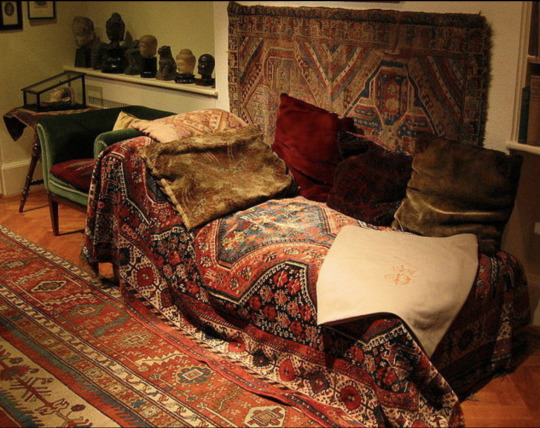
(Freud's actual couch.)
173 notes
·
View notes
Text
Grief as concept in The Gazette's 'Dark Age' - Part 1
Part 2
Part 3
Introduction
Grief, in its essence, encompasses a myriad of natural responses triggered by the loss of someone significant in our lives. However, grief isn't confined solely to the departure of a loved one; it extends to the loss of meaningful connections, dreams, aspirations, and even possessions. Whether it's the end of a friendship, leaving a job or home, parting with a beloved pet, or the destruction of a cherished object, each instance of loss can evoke profound feelings of grief.
The notion of "grief work," originating from Freud's perspective, implies a process of detachment from the deceased. However, this concept may not always align with our personal experiences of grief (or with modern psychology’s approach). Similarly, traditional "stage theories" of grief tend to oversimplify the complex emotional journey by delineating distinct phases. Yet, grief is inherently subjective, and our experiences of it can vary widely, making it more apt to discuss the components rather than stages of grief.
Understanding the components of grief is essential, recognizing that they are descriptive rather than prescriptive. These components may coexist simultaneously, and some may be absent altogether. Grieving is not a linear process, there is no predetermined timeline dictating when one should progress from denial to anger, for example. However, the value of stage theories lies in emphasizing that grief is indeed a journey, and every emotion experienced along the way is valid and indicative of progress towards acceptance.
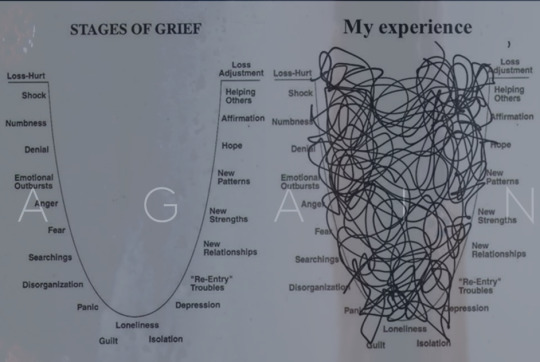
The album Dogma, released in 2015, stands out as The GazettE's most intense and meaningful work to date. Its powerful visuals, deep musical arrangements, and poignant lyrics evoke strong emotions and touch on a range of topics. After the release of Dogma, the band added two singles, Ugly and Undying, to round out the album's theme. Together, these three works, along with their accompanying Dogmatic tours, are often referred to as the Dark Age. Dark Age consists of several stages (like grief itself), and this dark period ends with the Dogmatic Tour Final, symbolically titled as 漆黒 (shikkoku, "the blackest black").
Just as Shikkoku represents the darkest and most profound phase of Dark Age, the Dogma-triptych represents the pinnacle of The GazettE's exploration into darkness. The songs and overall concept of Dark Age are intricate, yet this complexity allows for personal interpretation and reflection. Dark Age acts as a mirror - a dark mirror indeed - where listeners can continually uncover new layers of meaning. Beyond its surface themes, the songs of Dark Age also delve into the complexities of grief.
In the following sections, I'll take you through the songs of the Dogma album, as well as the singles Ugly and Undying, in the same order they were performed during the Shikkoku live. We'll explore how these songs relate to theories of grief and how they navigate themes of death and loss.
Part 1
The opening track of Dogma, titled NIHIL, derives from the Latin word meaning "nothing." This term symbolizes the initial phase of grief when a sense of emptiness and emotional numbness emerges. Sometimes, we may not fully grasp the gravity of the situation, leading to a feeling of detachment from reality. This aspect of grief, characterized by emotional detachment and shock, is identified by British psychiatrist John Bowlby as the first stage of the grieving process based on attachment theory.
The album's second track and title song is DOGMA, which in both its musicality and lyrics raises a very strong theme. The ominous, mournful sound of the harpsichord reminiscent of Bach is accompanied by heartfelt singing and a deep, slow chant: “I deny everything / I deny all of it", which introduces the concept of denial. “Dogma" is a Greek-origin word and can be translated as "what has been proven right". In today's sense, we use this word for a principle of a religion or ideology that is unquestionable – and what could be more unquestionable from a spiritual point of view than death? Although our minds are aware that death is a final state, we still protest against it.
Denial, along with the shock described in NIHIL, constitutes the initial stage of the "five stages of grief”, a widely recognized theory associated with Swiss-American psychiatrist Elisabeth Kübler-Ross. Originally developed for understanding the process of dying, as she was working in hospice care with terminally ill patients, this model may not fully capture the experiences of people who lost a significant person in their lives. Dr. H. Norman Wright later expanded the Kübler-Ross model into a seven-stage framework, refining its phases while preserving its fundamental structure.
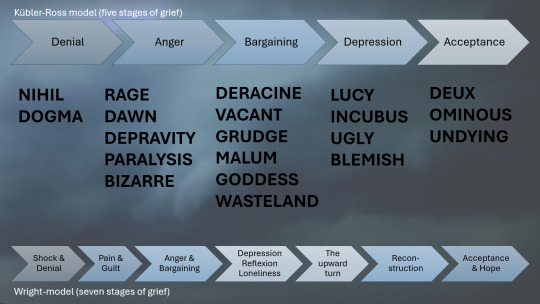
DOGMA showcases a wide range of grief components: alongside the theme of denial, it also includes anger towards the stupidity of others, arguing with God, and mentions the funeral as a separating transitional rite (闇を纏い孤高は儀に向かう – "cloaked in darkness, I must face the ceremony alone"). However, the most beautiful expression of the true essence of grief may be found in the last three lines in English: "I will blacken out this world / Darkness in the world / Starts tonight" – because grief almost envelops the mourning person in darkness, marking the beginning of a new era – the Dark Age.
The third song on Dogma, titled RAGE, already alludes to the second stage of the Kübler-Ross model and the third stage of the Wright model: anger. The key question of this phase is "why did this happen to me?" (This question later recurs almost literally in BLEMISH, emphasizing that in the grieving process, the stages may repeat.) Anger during grief can manifest in various ways: towards the fact of death ("We cannot change this fact, it is done"), towards the "dumb" masses (as DOGMA also suggests) who are unable to understand what we are going through; it can be directed towards someone we consider guilty of the loss we suffered, towards the deceased who left us alne, and also - towards ourselves. In RAGE, Ruki uses vulgar expressions to express anger ("shithead", "dickhead", "shitty looser"), while outwardly addressing his words to a single person, who is none other than the "sad old geezer" (God?), who can no longer save us ("Too late / this asshole cannot be saved"), who betrayed us ("How do you use us?") and left us stranded, both as individuals and as a community ("The generation is our last one"). Addressing God is also part of the bargaining according to the Kübler-Ross and Wright modelsas spirituality frequently becomes a factor in grief, involving the higher power capable of granting and ending life.
As we move forward to the next track, DAWN, we encounter a subtle yet significant shift in tone. The very title of the song suggests the promise of emerging from darkness into light, evoking a sense of hope and renewal. However, despite this optimistic connotation, the essence of the composition remains entrenched in the depths of despair and uncertainty.
The song begins with a reminiscence, pulling us back into NIHIL (愛し果てた過去 抉り出し歌う /空白の底に - "I sing, digging up the memories of the beloved past", "An evil spell my life"). However, hope is best symbolized by the imagery of 惑乱の時を越え /あぶくを立てる感情を ("beyond the momentary confusion / emotions come to surface"), since grief requires the full spectrum of emotions for its expression.
DEPRAVITY again evokes the state of hopelessness after DAWN (どこまでも深く闇は俺を離さない - "darkness completely engulfs me and won't let go", 眠れぬ夜と生きた – "I lived through sleepless nights"), and also states that the emotions that surfaced no longer support the grief process (涙も枯れてしまった – "my tears have dried up"). However, the setback is only apparent: modern grief theories no longer think in such linear processes, but rather in a system where the griever oscillates between emotions. A "normal" grief (i.e., not "complicated" grief) follows a natural pendulum movement: sometimes focusing on experiencing the loss, sometimes shifting focus to the intention of restoration, and back. This theory of grief processing is called the associated with Margaret Stroebe and Henk Schut, and could be illustrated with the following diagram:
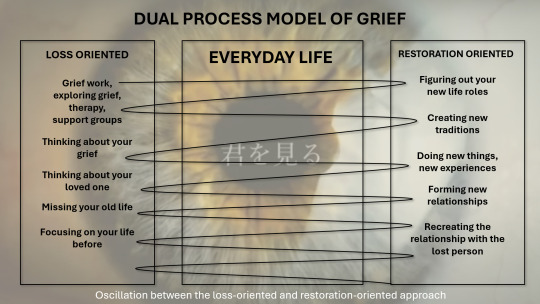
DEPRAVITY introduces the theme of seeking meaning with its interrogation of God (執念の塊がぶちまけた暴力を / 罪と呼ばず神と讃えれるか?- "how can you praise a god who unleashes violence without calling it sin?"), questioning what kind of god allows suffering and the death of the people created in his image. In grief and loss, seeking meaning is a natural human reaction: we create mental models of the world in which fundamental truths (DOGMA) operate ("This cannot happen to me"), and when unexpected loss occurs, it shatters our previous worldview. In the process of rebuilding, it's not just the lost person that needs to be mourned, but also the trust in life itself – because if this horror can happen, which shouldn't have happened, then basically anything can happen. This distrust, or uncertainty, is what brings the need for seeking (and finding) meaning (Dr. Robert Neimeyer's meaning reconstruction theory): it necessitates the creation of new narratives, bridging the gap between past and future, transcending the experience of loss.
DEPRAVITY brings up realizations from the depths (真実の裏はいつだってそうさ – "there's always something behind the truth"), which we were not aware of before experiencing loss: how important the lost person was to us (繋いだ心が/ 通わせ合った願いが – "connected hearts / and shared hopes"), and with them, not only did we lose the other half, but also the future we had dreamed of, where the deceased had a place, and where the void formed (望まぬ終わりに何を失う? - "what is lost with the unexpected end?").
PARALYSIS continues along the same train of thought, but much more prominently. Ruki stated about this song that it draws from a personal experience, a specific story, and is about his own weakness, vulnerability. Personally, I find it beautiful how Ruki integrates English idioms into Japanese lyrics because it gives a sense as if he's singing words highlighted in bold and italics: everything has emphasis, and it points back to the fact that despite seeking truth, secrets remain forever hidden from us ("Lies are stacking up", "Past... Buried... Forever"). Although the title of the song means "numbness," it rather refers to a numbness of action than emotional numbness, as emotions – especially pain – come back with renewed vigor (本能のまま絡まり出した感情が / わからないくらい痛い, "these instinctively tangled emotions / hurt more than I thought"), and cannot be suppressed (寂寞に埋まる 私の生命 / 吐き出せば また孤独に還ってしま, "my life is buried in loneliness / no matter how hard I try to vomit it out, loneliness always returns"). It's significant that he wants to vomit out loneliness (吐き出す, hakidasu – "to spit out, to vomit"), as continuous nausea, seemingly independent of any bodily cause, often appears among the physical symptoms of grief. (Other commonly occurring physical symptoms include: insomnia or hypersomnia, increased appetite or loss of appetite, headaches or other bodily pains.)
BIZARRE provides a momentary glimpse into the grief process, considering that here Ruki wrote the lyrics about a specific phenomenon, juvenile crime, yet this song also contains numerous references to violence and death, as if suggesting: hell itself is the terrible place we live in, where innocent people die.
Continue to part 2
12 notes
·
View notes
Text
Common people and representation
While there are people who do certainly want representation in fiction, sometimes not in ways we currently expect it to be, there was something of a phenomenon in western fanfiction about stories involving everyday people but set in the Marvel world for instance. Like you have people speculating on what’s like to be an ordinary person in a world full of superheroes, well there are some official publications that kind of answered the question in a way. Over at DC Comics, there was something like Gotham Central. It’s about ordinary police officers solving crime in Gotham City, with some appearances by Batman himself.
Then you have something like Ruins for Marvel Comics as written by the disgraced Warren Ellis, while it is interesting to use something like Marvel as a backdrop for more mundane stories but it does poke at the inherent limitations of the superhero genre. It’s possible to push boundaries with the superhero genre, though those who successfully do have interests outside of the superhero school of storytelling. I suspect somebody like Greg Rucka and who else wrote Gotham Central must have read a lot of crime fiction and/or show interest in real world forensics and law enforcement, there are likely some fanfiction writers who do and have done the same.
But the superhero genre absent of these influences has limitations that make it harder to focus on the lives of ordinary civilians or even superpowered civilians because of the unspoken expectation of superpowered characters is to fight each other, even if nonpowered characters also get in the act themselves. Not to mention the inherent vigilante angle is something that elides those of other cultures, especially if it’s something that goes against their cultural values or even wallows in sociopolitical vices. To successfully pull off these new influences and ideas is to wallow in something new and different yourself, that’s to do an angle that most superhero writers rarely if ever do.
Supposing if you have superpowered characters who have no inclination towards either crimefighting nor criminal activity that they might as well parlay their abilities into something really useful, a character like Cypher (who has the ability to understand and learn new languages well) would easily find work as an interpreter or a translator. Another would be a silk-making character who gets into weaving since this is what actual people do with silk-making, the only real difference is that this character skips the whole killing the caterpillar in the cocoon thing. Writers who make silk-making characters do stereotypical superhero stuff likely largely read Spider-Man comics.
This sounds harsh of me to say but it is telling that if you don’t read, learn or do anything else then you risk telling the same thing all over again, reuse the same old tired tricks and that’s almost all you can do. Being open to new ideas, experiences and activities can make a difference in not only telling a new story but also new stories featuring familiar characters, concepts and set-ups this way, otherwise we’d get really creatively bankrupt stories where it’s clear writers have little else to do because they have little else to say. It seems those who came up with the common people stories were pretty creative in some way, but this being amateur stories does show the other limitations.
When it comes to writing a story for DC and Marvel, especially at this point, that while diversity in storytelling is encouraged and enabled it is only to an extent. For every Gotham Central, there’s another straight-up Batman story. This is also complicated by matters of readers being really attached to characters they know and like, that this is something DC and Marvel are willing to oblige and supply their every whim. A common people type story is something DC and Marvel have come close to publishing, something like Gotham Central for instance, but when emotional attachment to popular characters trumps desire for more experimental storytelling shows the limits of the superhero genre.
Not just artistically but also from a business perspective.
13 notes
·
View notes
Note
Are there anythings that you would have changed about The Sandman?
The show or the comic?
Plenty of things I'd change about the comic. As great as the story is, it is a product of its time and there are some underlying messages whether intentional or not that are inappropriate and fucked up and don't really belong such as:
The racism towards black women implied to be cursed to die violently when linked to Morpheus in some way following the Nada situation.
In fact the whole Nada story is pretty gross. When she thinks that by cutting her hymen she'll remove her virginity to put Dream off her, but then its stated that healing her hyman doesnt restore her lost virginity... like first of all. No. Second of all - shoving a rock up your vag does NOT remove your virginity lets not spread the message that it does.
The way Dream comes across a bit rapey in the Nada story overall and its not made clear how much influence Desire has in that.
The inherent misogyny which is typical of 80s/90s comics but in particular the violence towards women and overt sexualisation of women. Whether for shock value or not, its just not necessary.
The implied message that depressed and suicidal people should just kill themselves and everything will be better once they are gone.
The idea that a person who is depressed can be replaced by a better good version of themselves and even their family and friends will just treat that person as the new them. The implication that the depressed person isnt valued and must instead conform to the responsibilities and burdens of the system they are trapped in - rather than changing the system.
The concept that the moon is inherently transphobic and that witchcraft is transphobic just irks me as a pagan person- like yeah there are huuuuge problems in the community and the whole divine feminine and fucking womb magic bullshit is all over it but I really really hate how Sandman perpetuates that myth and indicates its the goddess that encourages that view and not asshole closed minded people. The moon isnt fucking transphobic FFS.
Everything about Gwen and Hobs relationship in Sunday Mourning. Its problematic AF and I hope I don't need to explain why.
Not a fan of the portrayal of Loki and Sigyn. Its too black and white for such a complex myth.
That fucking awful reaping joke in Collectors which I loathe with every fibre of my being.
Even with all these points I want to caveat this by saying that I love these comics. I KNOW that a lot of this is subjective and open to interpretation. These things have many shades of grey to them. I adore the comics in so many ways but that doesn't mean they dont have their issues. I know people are emotionally connected to these comics and this criticism isnt meant as an attack on them.
For the show, well tbh I think its practically perfect, but a couple of niggles:
That fucking awful reaping joke in Collectors - can't BELIEVE they kept that in. I mute my TV at that moment so I don't have to hear it every time.
Hob's slave trade ties - They needed clarity here and should have kept the regret in 1889 more obvious. I understand why they changed it but I think that topic should have been thought through better.
There were complaints I read about how black characters and black men in particular seem to disproportionately suffer violent deaths. I know this was unintentional and a simple matter of open casting for extras and minor characters which is a GOOD thing, but sometimes casting should be less blind, and more considered where minorities are concerned.
Some of the dialogue in Johanna Constantine's episode is clunky - but that only bothers me because I've watched it 284929294787 times and have it memorised.
Despair was handled poorly. It wasnt great rep for fat bodies (like me) and she comes across so weak and submissive to Desire. Which she just isn't at all in the comic. Thankfully it looks like they really did take that criticism to heart and made positive changes in Dead Boy Detectives. She was fabulous in her cameo in that.
Not enough gay sex. The 1 star homophobic reviews really overexaggerated on that and left me disappointed. There should have been at least 1 gay or lesbian sex scene in every episode. Do better season 2. Do better. (For legal reasons this one is a joke - Sandman is a goldmine of queer rep and should be on every queer fans watch list 100 times over)
There you go. No piece of media is perfect. There can always be changes and improvements, but the Sandman is a story that really does fit the description of masterpiece. I think my ideas of things that need to change are generally matters of framing. I dont think the comic story should be drastically changed in the show, I don't think it should be given a different ending. Its a tragedy after all, but tragedy can come in many forms and perhaps the story can be adjusted so the tragedy isnt so harsh. But anyway. This is all just my opinion and as with all things i'm sure there will be plenty of people who disagree with me.
#the sandman#sandman meta#sandman analysis#sandman comic spoilers#racism discussions#upsetting themes#misogyny discussions#transphobia discussions#suicide discussions#asks#dead boy detectives spoilers
10 notes
·
View notes